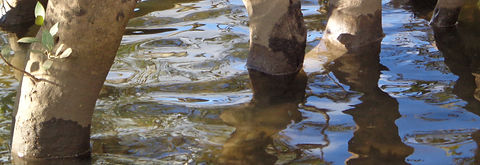
stories
.png)
Bernadette Flynn has spent many years researching the historical records of the Spencer area along with evidence of first contact and local Aboriginal resistance to colonial settlement. She has interrogated newspapers and the archives to locate photographs and tease out information about the river people, their activities and social life. Oral histories have also been collected, the living memories of long term residents and settler family stories. She is delighted to bring these to a wider audience through written articles, posts, podcasts and video recordings.
featured story: the butcher boats
The butcher boats started trading on the Hawkesbury around the 1900s. Without the benefit of ice or refrigeration butcher boats brought meat supplies to people all along the river. Aside from providing food, the fat from the meat was used for a range of domestic purposes, including soap-making and as a spread on bread, finally the bones were burnt for bone-meal to feed the chickens.
Bill Parkes owned one of the early butchers boats, the Iris which from about 1910 delivered meat along the river from Wisemans Ferry to Mangrove Creek. From records from another butcher boat (the Ruby Jean) a ten to twenty pounds roast sold for five to ten cents a pound. At one time under different owners the Iris ran from the Spencer Store.
The Iris at Albert Henry Craft’s wharf on Mangrove Creek around 1910. Image, courtesy of Gosford Library.
Other butcher boats trading on wharves around Spencer and Mangrove Creek were the Primrose, Lilly White and the Native Rose built by Archie White of Mangrove Creek. The last of the butcher boats was the Ida M built in 1913 by Bill Cox of Mangrove Creek for George Mitchell.
The Ida M: George Mitchell on the roof with son Roy on the deck; in the cabin, Mr Grant from Paling’s pianos; Reg Mitchell, brother of Roy; Ida May sister after whom the boat was named and mother Mary Mitchell. Photograph from Dennis Mitchell, published in Hawkesbury River Boats and People, by Jean Purtell.


_edited.png)
more stories

The Inn of the Damned-Mangrove Creek
'Marginalised in a deserted road in the isolated Australian forest, there is a horrible godforsaken inn’. The 'Inn of the Damned' rumoured to be a haunted house was originally owned by Mr and Mrs Gardiner and served as ‘Gardiner’s Guest House’ a stopping place for travelling salesmen when the road was the main highway from Sydney to the Central Coast.

Ma Hannah's Boatshed-Spencer
Ma Hannah ran the last of the fishing boatsheds along the river. People would travel from Sydney, arriving at Brooklyn via train and then travel by ferry to stay at her Spencer boatshed for a weekend of men only time. There was no charge for staying there but you had to hire a boat. Bunks were made out of hessian bags between two pieces of timber and the toilet was a can going directly into the river or the waste was buried in the ground

Bumblefoot-
Mangrove
In 1824 Bumblefoot staged a series of attacks against the white settlers on the Lower Hawkesbury. Bumblefoot’s actions against the settlers followed the pattern of Aboriginal resistance along the Hawkesbury with attacks on settlers, crops and property – partially for food but mainly as a means of economic warfare. He was charged with murder in the supreme court. Biraban, an Aboriginal leader of the Awabakal people was brought in as a witness

.png)
_edited.png)

